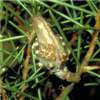 Flowers and leaves. Photo © W.R.Barker |
 Fruits and leaves. Photo © W.R.Barker |
 Fruit and leaves. Photo © W.R.Barker |
Synonymy
Hakea decurrens R.Br., Suppl. Prodr. Fl. Nov. Holl. 27 (1830) subsp. decurrens
Hakea tenuifolia var. decurrens (R.Br.) Domin, Biblioth. Bot. 89: 592 (1921). T: Barren Lands of the Western Interior, s.d. [1818], C.Fraser 41 [Oxley 2nd Expedition]; lecto: BM, fide W.R.Barker, J. Adelaide Bot. Gard. 17: 189 (1996); remaining syntype: Oxley's 2nd Expedition, s.d. [1818], [C.Fraser] 46; syn: BM; ?isosyn: G-DC.
Hakea brachyrrhyncha F.Muell., First Gen. Report 17 (1853), nom. nud.; Meisn., in A.L.P.P. de Candolle, Prodr. 14: 401 (1856), pro syn. under H. acicularis.
[Hakea acicularis var. lissosperma auct. non (R.Br.) Benth.: G.Bentham, Fl. Austral. 5: 515 (1870), p.p.]
[Hakea sericea auct. non Schrad. & J.C.Wendl.: A.J.Ewart, Fl. Victoria 407 (1931), p.p.; N.T.Burbidge, Fl. Austral. Cap. Terr. 146 (1970), p.p.; J.H.Willis, Handbook Pl. Victoria 2. Dicot. 51 (1973), p.p.]
Description
Semi-prostrate to erect, bushy to scrambling shrub, 0.4–2.4 m tall. Branchlets sparsely to densely appressed-pubescent or -sericeous. Leaves widely spreading, grooved below to varying extents, 1.5–8 cm long, 0.7–1.6 mm wide, sparsely to moderately appressed-sericeous, quickly glabrescent; apex porrect, with mucro 1–3.5 mm long.
Inflorescence axillary umbel of 1–6 white to pink flowers; rachis simple, 0.5–2.8 mm long, with tomentose or appressed white and/or ferruginous hairs, extending onto pedicels; pedicels 1.2–4.8 mm long. Perianth 4.2–7.2 mm long, glabrous. Pistil 8.5–12.2 mm long.
Fruit 1.8–3 cm long, 1–1.8 cm wide, finely or coarsely tuberculate, obliquely ovate to broadly ovate; beak small to moderately large, sparsely pustulate or smooth; horns 1–5 mm long; valves with pale wood extending c. 3/4 way to style base, pale wood zone 3.5–6 mm wide; red-brown wood zone 1.2–2 mm wide. Seed 17–23 mm long, 6.5–10.5 mm wide; wing 3/4 to fully down one side only, dark blackish brown with hyaline network of minute areoles.
Distribution and ecology
Found only on the western slopes and adjacent tablelands of the Great Dividing Ra. in N.S.W. and A.C.T. Occurs in thick scrub to open Eucalyptus woodland or forest, often in hilly country, at an altitude of 430–900 m.
To plot an up to date distribution map based on herbarium collections for this species see Australia's Virtual Herbarium. Localities outside the native range may represent cultivated or naturalised records.
Flowering time
Flowers May–Sept., usually July.
Derivation of name
From decurrens, Latin for decurrent or prolonged below the point of insertion, a reference to the insertion of the leaf on the stem in this species.
How the infraspecific taxa differ
The subspecies primarily differ in their fruit and branchlet hair characters as shown below. Enright & Goldblum (1999) indicate that ssp. physocarpa (see note under that subspecies) is not lignotuberous in the Grampians but the species was generally described as lignotuberous by W.R.Barker in the Flora of Australia treatment. Further observations are required across the range of the species to clarify this characteristic to clarify this characteristic in relation to each of the subspecies.
| | Branchlet hairs | Fruit width, cm | Fruit: red-brown layer width, mm | Fruit: pale wood width, mm | Locality/Ecology |
| ssp. decurrens | appressed, soon lost | 1-1.8 | 1-2.5 | 3.5-6 | W slopes and plains of |
| ssp. platytaenia | raised, persistent | 2.6-3.5 | 3-5 | 8-15 | Coastal windswept heaths, NSW, VIC and Bass St islands |
| ssp. physocarpa | appressed, soon lost | 1.3-2.5 | 1-2.5 | (4.5-)6-12 | Non-coastal se NSW, Vic, Bass St; widely naturalised –SA, Tas, NSW, |
Relationships
Part of Section Hakea of Bentham (as Euhakea) and characterised by a non-conical pollen presenter, leaves without obvious venation, perianths with or without hairs and fruits with or without horns. Barker et al. (1999) recognised a number of informal morphological groups within the section.
H. decurrens was treated as part of the Sericea group, a predominantly eastern states group characterised by their simple terete leaves, few-flowered inflorescences, hairy pedicels and solitary, prominently woody fruits, these often markedly verrucose or pusticulate and usually with horns.
Other members of the group are H. actites, H. constablei, H. gibbosa, H. kippistiana, H. leucoptera, H. lissosperma, H. macraeana, H. macrorrhyncha, H. ochroptera, H. sericea and H. tephrosperma, predominantly from the eastern states of Australia.
Representative specimens
N.S.W.: the Mullions Ra., 22.5 km NNE of Orange, R.Coveny 4189 (DNA, NSW); 19 km N of Rylstone, 11 Apr. 1953, L.A.S.Johnson s.n. (AD, NSW); Pilliga Scrub, June 1967, N.Perry s.n. (NSW). A.C.T.: Black Mtn, W.R.Barker 5681 (AD).
Weblinks
Link to PlantNET treatment.
More photographs of this species can be seen on the Australian National Botanic Gardens site.
There are images of H. decurrens in the Key to Tasmanian Plants pages.
Further illustrations
I. Holliday, Hakeas. A Field and Garden Guide 64-65 (2005)